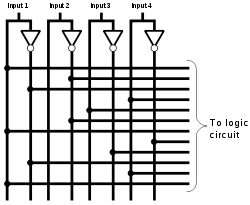- Manhattan wiring
-
See also: Taxicab geometry
Manhattan wiring (also known as right-angle wiring) is a technique for laying out circuits in computer engineering. Inputs to a circuit (specifically, the interconnects from the inputs) are aligned into a grid, and the circuit "taps" (connects to) them perpendicularly. This may be done either virtually or physically - that is, it may be shown this way only on the documentation and the actual circuit may look nothing like that; or it may be laid out that way on the physical chip. Typically, separate lanes are used for the inverted inputs and are tapped separately.
The name Manhattan wiring comes from looking at such a circuit diagram. It is reminiscent of how the roads in Manhattan, New York tend to criss-cross in a very regular grid.
Manhattan wiring is often used to represent a programmable logic array.
Alternatives include X-architecture wiring, or 45° wiring, and Y-architecture wiring (using wires running in the 0°, 120°, and 240° directions).
References
- Yupo Chan (2005). "Chapter 3: Measuring spatial separation: distance, time, routing and accessibility". Location, transport and land-use: modelling spatial-temporal information. Springer. ISBN 3540210873. http://books.google.com/books?id=kZYl2v7Xw7wC&pg=PA120.
Categories:- Electronic circuits
- Electronics stubs
Wikimedia Foundation. 2010.

